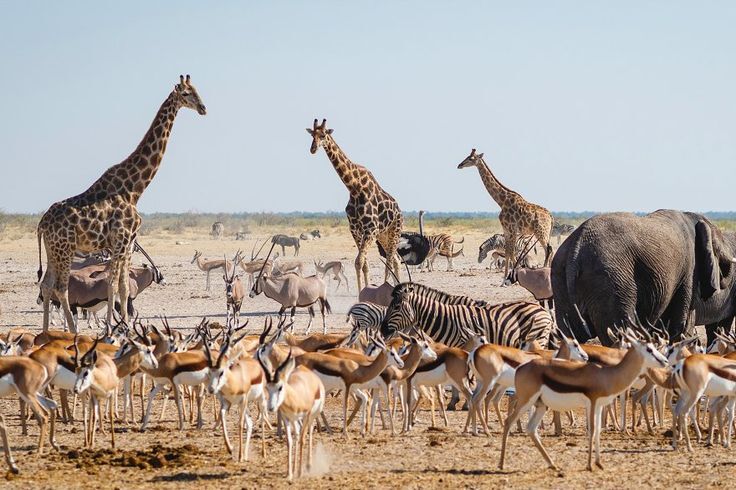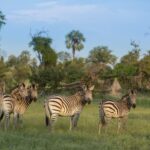Etosha National Park Namibia
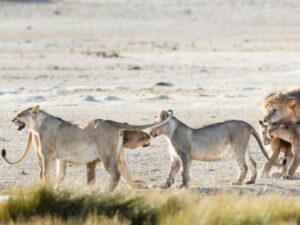 Etosha National Park, Namibia’s top wildlife reserve, draws visitors with its ecosystems, diverse wildlife, and unique landscapes. This protected area covers over 22,000 square kilometers, making it a prime destination for safari lovers and nature enthusiasts. At its core lies the Etosha Pan, an enormous salt flat visible from space. This natural feature shapes the park’s climate, flora, and fauna. In this article, we’ll show why Etosha National Park is known as the “jewel of Namibia” and a top safari experience in southern Africa.
Etosha National Park, Namibia’s top wildlife reserve, draws visitors with its ecosystems, diverse wildlife, and unique landscapes. This protected area covers over 22,000 square kilometers, making it a prime destination for safari lovers and nature enthusiasts. At its core lies the Etosha Pan, an enormous salt flat visible from space. This natural feature shapes the park’s climate, flora, and fauna. In this article, we’ll show why Etosha National Park is known as the “jewel of Namibia” and a top safari experience in southern Africa.
The Unique Landscape of Etosha National Park
Etosha’s landscapes are incredibly diverse. They range from open plains and mopane woodlands to the iconic Etosha Pan. This salt flat, a remnant of a prehistoric lake, covers nearly a quarter of the park. Though usually dry, it turns into a shallow lake during the rainy season, attracting flocks of birds, especially flamingos. Their bright colors create a striking contrast against the white salt crust.
The seasonal transformation of the pan makes Etosha stand out. During the dry season, its cracked surface contrasts with the life gathered around waterholes. Other areas feature grasslands, woodlands, and savannas. Each of these habitats supports different wildlife, offering visitors a range of views and photo opportunities throughout the park.
Abundant Wildlife
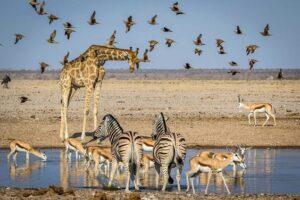 Etosha hosts over 114 mammal species, making it one of the most exciting parks for game viewing. Waterholes attract a wide variety of animals, providing visitors excellent chances to observe interactions. Here are some standout species that make Etosha a perfect safari destination:
Etosha hosts over 114 mammal species, making it one of the most exciting parks for game viewing. Waterholes attract a wide variety of animals, providing visitors excellent chances to observe interactions. Here are some standout species that make Etosha a perfect safari destination:
- Lions: A healthy lion population roams here. You’ll often spot these predators near waterholes, hunting antelopes and zebras.
- Elephants: Etosha is home to uniquely adapted elephants with massive size and white-gray coats from the dust. You’ll frequently see them around water sources, socializing and cooling off.
- Rhinos: Both black and white rhinos thrive here, but Etosha is especially famous for conserving black rhinos. They are often spotted at waterholes, particularly in the early morning and late evening.
- Giraffes: Giraffes bring grace to Etosha, often browsing on acacia trees in woodlands and open areas.
- Springbok and Oryx: These iconic antelopes thrive in Etosha’s dry climate. Springboks display their unique “pronking” leaps, while oryx, with their straight horns, are a majestic sight.
- Birdlife: Etosha is a paradise for birdwatchers, with over 340 species recorded. The rainy season brings flamingos, pelicans, and other waterbirds to the seasonal lakes of the Etosha Pan. Notable birds include ostriches, secretary birds, and numerous raptors.
The Waterholes of Etosha National Park
Etosha’s network of waterholes is essential to both its wildlife and visitors. Many are near main roads and campsites, making them easily accessible for viewing. These waterholes attract animals throughout the year, especially during the dry season.
Okaukuejo and Halali are two notable waterholes near rest camps. Okaukuejo’s floodlit waterhole is popular for nighttime viewing, where rhinos, elephants, and lions often appear. Halali’s waterhole, set in scenic hills, offers a quieter, scenic place to observe wildlife. Each waterhole has a unique layout, creating varied environments for gathering animals.
A Birdwatcher’s Paradise
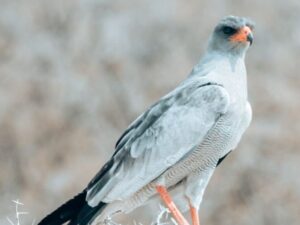 Etosha is not just about large mammals. Birdwatchers find plenty to admire as well. From November to April, the rainy season draws migratory species, filling the park with vibrant colors and calls. Flamingos form large colonies on the shallow waters of the Etosha Pan, creating a stunning pink landscape.
Etosha is not just about large mammals. Birdwatchers find plenty to admire as well. From November to April, the rainy season draws migratory species, filling the park with vibrant colors and calls. Flamingos form large colonies on the shallow waters of the Etosha Pan, creating a stunning pink landscape.
In addition to flamingos, Etosha hosts unique species like the kori bustard, Africa’s heaviest flying bird, and the colorful lilac-breasted roller. Raptors like martial eagles and tawny eagles, as well as ostriches, are common sights. Secretary birds, known for hunting snakes, add to the rich birdlife of Etosha.
Self-Drive and Accessibility
Etosha National Park ranks as one of the easiest safari destinations in Africa, especially for self-drive visitors. The park has a well-maintained road network with clear signage, and maps are available at each entrance. For those preferring guided tours, experienced guides offer insights into Etosha’s ecosystem and wildlife.
The main entrance, Andersson Gate, is near Okaukuejo. Two other gates—Namutoni in the east and Galton Gate in the west—make entering easy for visitors. Rest camps offer a range of accommodations, from camping to luxury lodges, to ensure comfort for all travelers.
Etosha National Park’s Commitment to Conservation
Namibia has a global reputation for its conservation efforts, and Etosha plays a key role in preserving its natural heritage. Established in 1907, Etosha was once one of Africa’s largest game reserves. Although its boundaries have shrunk, it remains a cornerstone of Namibia’s conservation work.
The park leads extensive programs to protect endangered species, especially the black rhino. It serves as a safe haven for these animals, with strict measures to ensure their survival. Etosha also supports sustainable tourism, with park fees funding conservation and anti-poaching projects.
Best Times to Visit
Choosing the right season can enhance your visit to Etosha. Each season offers unique opportunities:
- Dry Season (May to October): Known as the best time for wildlife viewing, the dry season forces animals to gather at waterholes, making them easier to spot. Thinner vegetation improves visibility for both landscapes and animals.
- Rainy Season (November to April): The rainy season transforms Etosha into a lush paradise, with seasonal flowers blooming and the pan filling with water. Birdwatchers particularly enjoy this season, as migratory birds like flamingos arrive. Although animals are more spread out, the scenery is breathtaking, and there are fewer crowds.
Essential Tips for an Etosha National Park Safari
Make the most of your Etosha safari with these tips:
- Stay at Park Camps: Staying at Okaukuejo, Namutoni, or Halali maximizes wildlife sightings and access to waterholes.
- Visit Multiple Waterholes: Different waterholes attract different animals at various times, so explore several to see more wildlife.
- Bring Binoculars and a Good Camera: With diverse birdlife and open landscapes, binoculars and a camera with good zoom are essential to capture memorable scenes.
- Respect Wildlife Rules: Keep a safe distance and stay inside your vehicle. Respecting the animals’ space is crucial for safety.
- Consider Guided Tours: Even in a self-drive-friendly park, guided tours enhance the experience with local insights into the park’s history, ecosystems, and wildlife.
Conclusion
Etosha National Park is an unforgettable safari destination that showcases Namibia’s wild beauty. From its iconic salt pan to its rich wildlife and birdlife, Etosha offers a unique and accessible African adventure. Its waterholes, conservation focus, and scenic landscapes create the perfect safari setting.
As one of Africa’s jewels, Etosha invites you to explore Namibia’s landscapes, witness thrilling animal interactions, and support the conservation of this remarkable ecosystem.

